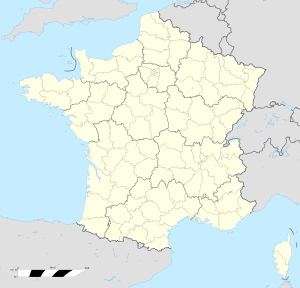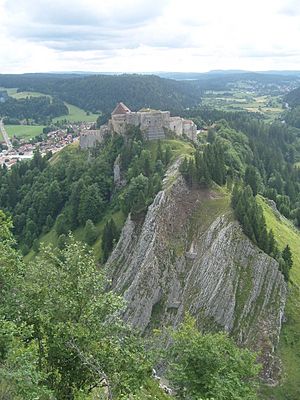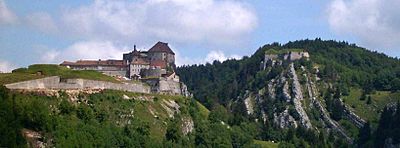Fort de Joux facts for kids
Quick facts for kids Fort de Joux |
|
|---|---|
| Château de Joux | |
| Part of Maginot line | |
| La Cluse-et-Mijoux Near Pontarlier in France |
|
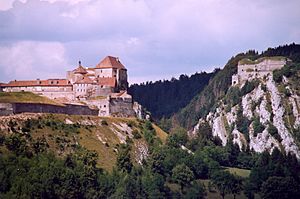
The Fort de Joux
|
|
| Coordinates | 46°52′21″N 6°22′27″E / 46.8725°N 6.3742°E |
| Type | Castle, fort |
| Site information | |
| Owner | Communauté de communes du Larmont |
| Open to the public |
Yes (tours, events) |
| Site history | |
| Built | 11th century |
| Built by | Lords of Joux, Dukes of Burgundy, Charles Quint, Vauban, Joffre. |
| In use | until 1958 |
| Materials | Limestone and tufa |
| Battles/wars | 1814, 1871, 1940 |
The Fort de Joux (also called Château de Joux) is an amazing old castle in France. It later became a strong fort. You can find it in La Cluse-et-Mijoux, high up in the Jura Mountains. This fort was very important because it guarded a narrow mountain pass called Cluse de Pontarlier.
Contents
History of Fort de Joux
The Fort de Joux has changed a lot over many centuries. It started as a simple wooden building in the 11th century.
From Wooden Castle to Stone Fortress
The first owners, the Lords of Joux, rebuilt parts of it. They made the main tower (called a keep) and the outer walls from strong stone. This made the castle much safer.
Becoming a Border Stronghold
In 1454, Philip the Good, who was the Duke of Burgundy, bought the castle. He turned it into a fort to protect his borders. He added a ditch (moat) and places for soldiers to live (barracks). Over time, other powerful rulers owned the fort. These included Charles Quint and the Habsburgs. Each owner added new improvements to make it even stronger.
Vauban's Modern Design
One of the most famous people to work on the fort was Vauban. He was a brilliant military engineer. Between 1678 and 1693, he updated the fort with the latest designs. This made it a very modern and powerful defense for Louis XIV of France. France officially took control of the fort in 1678.
Later Battles and Upgrades
In 1814, the Austrians captured the fort for a short time. Later, in the 19th century, new forts were built nearby to help protect the area. In 1879, a military officer named Joseph Joffre (who later became a famous Marshal) updated the fort again. He made it part of the Maginot Line. This was a line of forts built to stop invasions, especially from Germany.
A Famous Prison for Important Figures
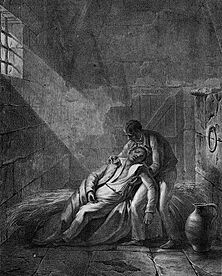
For many years, from the 17th to the 19th centuries, the fort was used as a prison. Some very famous people were held there. These included Mirabeau, a French writer, and Heinrich von Kleist, a German poet.
The most famous prisoner was Toussaint Louverture. He was a great leader of the Haitian Revolution. This revolution led to Haiti becoming the first free black republic. Toussaint Louverture sadly died in the prison at Fort de Joux on April 7, 1803.
Fort de Joux in World War I
Besides being a prison, the fort helped defend the region. It played a role in protecting France right up until the First World War.
What You Can See at Fort de Joux Today
Today, the Fort de Joux is a popular place to visit. It has a museum that shows off many old weapons. You can see over 600 rare weapons from the 18th to the 20th centuries. One special item is a very old rifle from 1717.
The castle also has a very deep well. It was once the deepest well in all of France! It was 147 meters (about 482 feet) deep. Even though it's now partly filled, it's still about 101 meters (about 331 feet) deep, making it the third deepest.
Since 1949, the French government has recognized the château as a monument historique. This means it's a very important historical site.
See also
 In Spanish: Fort de Joux para niños
In Spanish: Fort de Joux para niños
- List of castles in France


